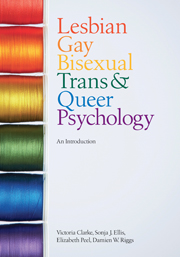Book contents
- Frontmatter
- Contents
- List of boxes
- Introduction: how to read and use this book
- Section I History, contexts and debates in LGBTQ psychology
- Section II Understanding social marginalisation in LGBTQ lives
- Section III LGBTQ experiences across the lifespan
- 7 Young people, coming out and identity development
- 8 Relationships
- 9 Parenting and family
- 10 Ageing and old age
- Conclusion
- Glossary
- Additional resources
- References
- Index
- References
9 - Parenting and family
from Section III - LGBTQ experiences across the lifespan
- Frontmatter
- Contents
- List of boxes
- Introduction: how to read and use this book
- Section I History, contexts and debates in LGBTQ psychology
- Section II Understanding social marginalisation in LGBTQ lives
- Section III LGBTQ experiences across the lifespan
- 7 Young people, coming out and identity development
- 8 Relationships
- 9 Parenting and family
- 10 Ageing and old age
- Conclusion
- Glossary
- Additional resources
- References
- Index
- References
Summary
Overview
• Paths to parenthood for LGBTQ people
• Comparing lesbian-, gay- and trans-headed families with heterosexual-headed families
• Moving away from a ‘proving otherwise’ agenda
• Looking inside LGBTQ families
Paths to parenthood for LGBTQ people
Until relatively recently, one of the most widely held stereotypes about lesbians and gay men was that they do not have children. Research on lesbian, gay and trans parenting has been underway since the early 1970s and a considerable body of knowledge has developed since then, so we know that this stereotype is not true! Although many non-heterosexuals choose not to parent, and one of the things they value about being non-heterosexual is a perceived freedom from social pressures to have children (Stacey, 2006), many non-heterosexuals are parents. Because of the difficulties of generating representative samples of non-heterosexuals that we discussed in Chapter 3, it is impossible to provide precise statistics on the numbers of non-heterosexual parents. However, a number of studies have found that around a third of lesbians and about 10 to 20 per cent of gay men are parents (there are no figures for the numbers of bisexual parents). Some psychologists have argued that these figures under-represent rates of parenting among marginalised racial and cultural groups. The suggestion is that members of these groups are less likely to identify with categories such as ‘lesbian’ and ‘gay’ and are more likely to be involved in heterosexual relationships, and as such are more likely to be parents (Bell and Weinberg, 1978).
- Type
- Chapter
- Information
- Lesbian, Gay, Bisexual, Trans and Queer PsychologyAn Introduction, pp. 194 - 215Publisher: Cambridge University PressPrint publication year: 2010



